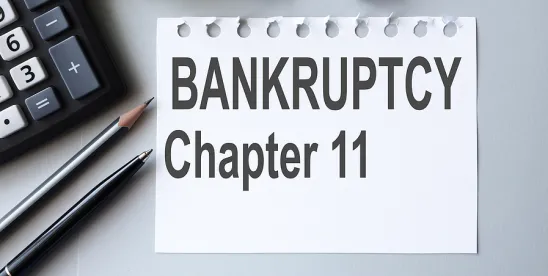Vendors, landlords, and other creditors often feel a sense of security when doing business with Chapter 11 debtors. The Bankruptcy Code, and even court orders entered at the outset of a bankruptcy case, seemingly provide a myriad of protections to those engaging in business with a company reorganizing under Chapter 11.
Indeed, Chapter 11 debtors often induce continued business by suggesting that they are “required” to pay all post-bankruptcy obligations in full. Nevertheless, these protections and assurances often prove to be optical illusions, leaving creditors holding the bag with significant unpaid post-petition obligations at the end of a bankruptcy case.
The recent Big Lots Chapter 11 bankruptcy filing is a massive warning signal that exposes the significant risks of doing business with Chapter 11 debtors.
Landlord Protections
The Bankruptcy Code provides heightened protections to landlords when dealing with Chapter 11 debtors. Pursuant to section 365(d)(3) of the Bankruptcy Code, a tenant debtor is required to “timely perform all the obligations of the debtor… arising from and after the petition date” under any unexpired lease. This means they must continue to fulfill lease obligations that come due after the bankruptcy filing until the lease is either assumed or rejected by the debtor.
Essentially, a landlord is entitled to receive post-petition rent payments as a high-priority administrative expense claim if the tenant does not pay in a timely manner.
Pursuant to the Bankruptcy Code, shopping center landlords are entitled to additional protections when a lease is assumed and assigned. In such circumstances, a Chapter 11 debtor must cure any defaults and provide “adequate assurance” of future performance under the lease.
If the lease qualifies as “a lease for real property in a shopping center,” a landlord is entitled to “adequate assurance” for certain specific obligations. “Adequate assurance” is intended to protect a landlord from a decline in the value of the subject premises if a lease is assumed. The assurances include requirements that:
- the financial condition and operating performance of any assignee be similar;
- percentage rent does not decline substantially;
- all other provisions of the lease apply, such as exclusive use clauses; and
- the tenant mix or balance at the shopping center not be disrupted.
“Adequate assurance” that a landlord will be compensated for any pecuniary loss is a condition to the assumption of a lease of real property in a shopping center. With such protections, landlords may feel a false sense of confidence when dealing with Chapter 11 debtors.
Trade Creditor Post-Bankruptcy Protections
The Bankruptcy Code also provides various protections to vendors that provide goods and services to Debtors after a bankruptcy is filed. Claims for such services are generally entitled to administrative expense priority status over other unsecured creditors. Further, vendors who deliver goods to debtors within twenty days before the bankruptcy filing are also entitled to administrative expense status under Section 503(b)(9) of the Bankruptcy Code.
Additionally, in many cases, Debtors seek orders allowing certain vendors to be treated as critical vendors. Based upon the doctrine of necessity, Debtors not only commit to paying critical vendors for post-petition goods, but must pay critical vendors for pre-bankruptcy claims.
Finally, to confirm a Chapter 11 bankruptcy plan, a debtor must show that it can pay all its administrative claims in full. Similar to landlords, trade creditors may also feel a false sense of post-petition security, given all of these purported protections.
Big Lots Chapter 11 Bankruptcy Leaves Administrative Creditors Massively Exposed
The recently filed Big Lots Chapter 11 bankruptcy case provides a stark illustration of the risks of doing business with a debtor post-bankruptcy. Big Lots’ proposed creditor protections proved to be mirages leaving post-petition claims substantially exposed to non-payment.
Immediately upon filing for bankruptcy protection, Big Lots provided certain assurances to its landlord and vendor community. To secure its Debtor in Possession financing, Big Lots’ Chapter 11 plan committed to a budget that included payment of landlord stub rent claims. Big Lots also commenced a critical vendor program, offering payment of pre-bankruptcy claims in return for continued open credit terms.
Big Lots also commenced a sale process that proposed to sell its business as a going concern, including over 800 stores, to Nexus Capital Partners (“Nexus”). With representations that a continued going concern business was in process, creditors were induced into continued business with Big Lots.
How the Big Lots Chapter 11 Plan Failed
As part of the sale to Nexus, Big Lots was required to deliver certain inventory value. To achieve the necessary asset value, Big Lots used its post-petition trade credit and incurred over $215 million in debt to build up its post-petition inventory. This was in addition to $38 million in 503(b)(9) twenty-day vendor claims, as well as additional post-bankruptcy landlord claims. Simply put, Big Lots exposed its trade credit and landlord constituents to well over $250 million of post-petition credit to close the deal with Nexus.
Due to Big Lots’ inability to deliver its asset value obligations under the Asset Purchase Agreement (APA) – despite pumping up over $200 million in trade credit – Nexus would not close the sale. This left Big Lots exposed to a complete fire-sale liquidation and a massive administratively insolvent estate, with little, if any, of the post-petition obligations to be paid.
GBRP Saves the Day, Sort Of
“Luckily,” total catastrophe was averted by a last-minute sale transaction with Gordon Brothers Retail Properties (“GBRP”) where between 200 and 400 stores will be saved. However, the GBRP transaction only provides minimal hope for recovery to post-bankruptcy vendors and landlords.
As part of its APA, GBRP will pay select post-petition creditors, leaving most vendors and landlords in the cold. GBRP’s APA protects professionals, certain landlords, and go-forward trade creditors without covering the post-petition obligations accrued to date. The proposed APA terms created categories of preferred administrative claimants, with the balance remaining prejudiced by the sale.
For example, Big Lots’ Chapter 11 wind-down budget increased a prior fee reserve for professionals by $13,438,000 for two months of continued service. In addition, certain landlords will be paid $17 million in satisfaction of unpaid administrative rent and Debtors will purportedly remain current on their rent going forward. This, while the $250 million in other post-bankruptcy claims remains largely unpaid.
Big Lots and GBRP carved out approximately $19 million in assets (tax refunds, litigation proceeds, and a percentage of real estate sales), which will remain behind to pay a paltry dividend to administrative claimants.
The creditor community raised concern that the GBRP sale violated the priority scheme of the Bankruptcy Code, by allowing Big Lots to pick and choose among its creditors. The court overruled the creditor community’s cries that proceeds of the GBRP sale be escrowed with distributions and priority to be decided post-closing. The Bankruptcy Court allowed the transaction to proceed per the terms mandated by GBRP.
Avoiding the Big Lots Chapter 11 Outcome
In sum, while numerous trade vendors and landlords engaged with Big Lots after the bankruptcy was filed, feeling secure that their post-petition claims would be paid, they are now left with over $200 million in post-petition debt, with only nominal distributions on the horizon.
Big Lots’ Chapter 11 provides a harsh lesson that no matter what protections or assurances are assumed, creditors must be vigilant in enforcing their post-petition rights and be wary when extending post-petition credit, or otherwise engaging in business with a Chapter 11 debtor.



 />i
/>i

